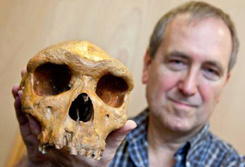Prof Chris Stringer
Our human evolution specialist nearly didn't go into anthropology, but he is now recognised as one of Britain's foremost experts in the field.

Early aspirations
Prof Stringer seized any opportunity to study human origins as a child, but since pursuing anthropology was not common career advice, he applied to medical school instead. While he was deciding whether to accept a place, he came across a prospectus for University College London, and discovered he could study human evolution for a degree.
He chose anthropology, and a subsequent PhD at the University of Bristol on the anatomy of human evolution saw him touring Europe on a shoestring, living in tents or youth hostels, before turning up at important museums to measure their human remains. Then a permanent position at the Natural History Museum opened up, and Prof Stringer has been here ever since, becoming the country’s foremost expert on human evolution.
Super specimens
Visiting the Museum as a child, one of the specimens Prof Stringer particularly remembers is a cast of the Broken Hill skull, the first early human fossil found in Africa. Now, he gets to work on the real skull, which, he says, is a ‘beautiful specimen’.
‘It’s that direct contact with the past,’ says Prof Stringer about what he finds most exciting about his research. ‘The fact that during excavations in Gibraltar, if you find a stone tool, the last person who touched that was a Neanderthal. There’s that emotional connection with these ancient people.’
Bringing the past to life
Prof Stringer has been involved in excavations in Europe and North Africa, but has a special connection to British sites. He worked on the Boxgrove finds, from a site in West Sussex that revealed the lives of some of the earliest colonisers of northern Europe. He also helped to excavate the Gough’s Cave remains, which show the complex behaviour of early modern humans in Somerset, nearly 15,000 years ago.
It was the scale of multidisciplinary work at Boxgrove that inspired Prof Stringer and his colleagues to form the Ancient Human Occupation of Britain Project. The project ran for 13 years, and culminated with the temporary exhibition Britain: One million years of the human story at the Museum.